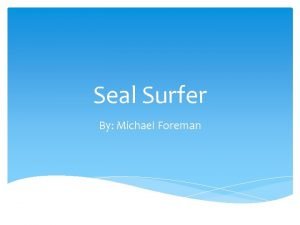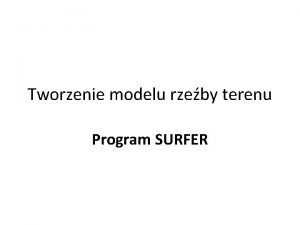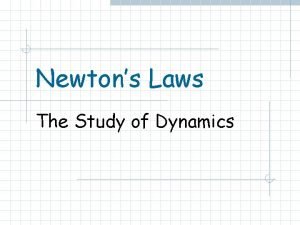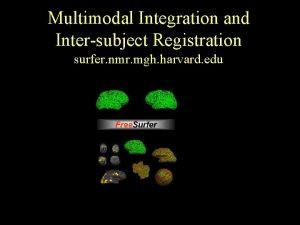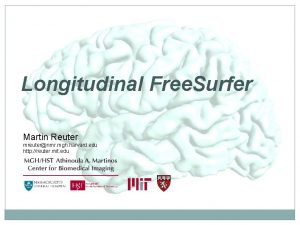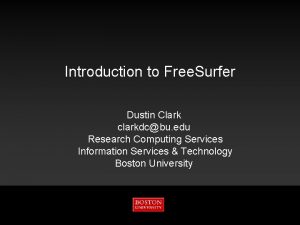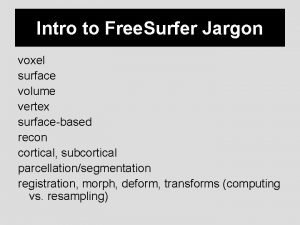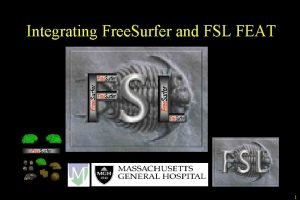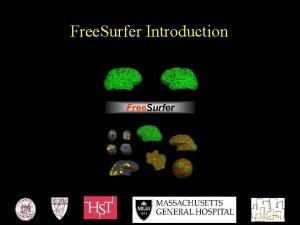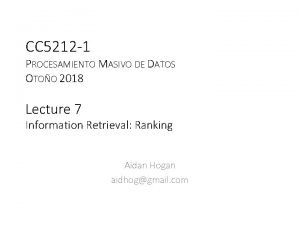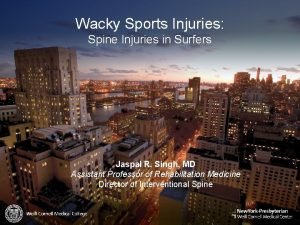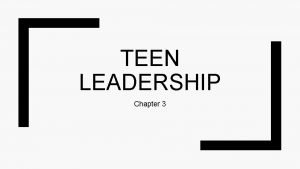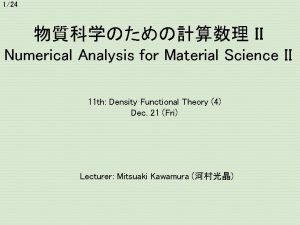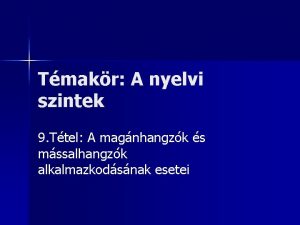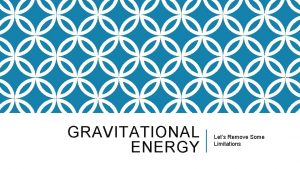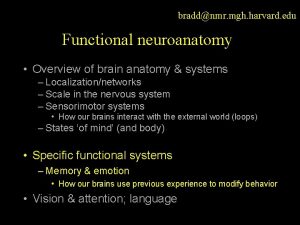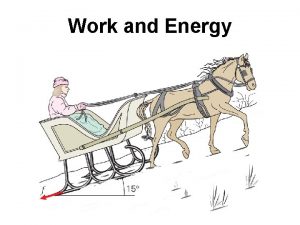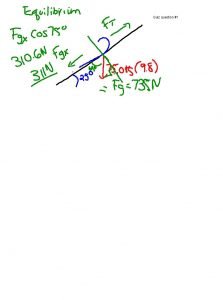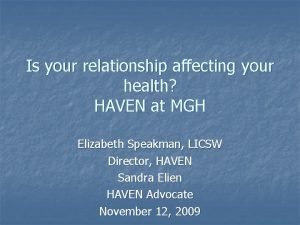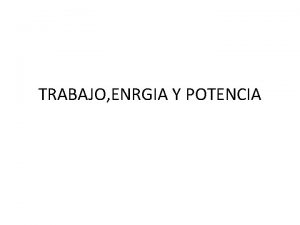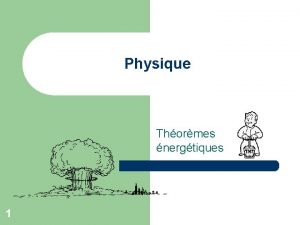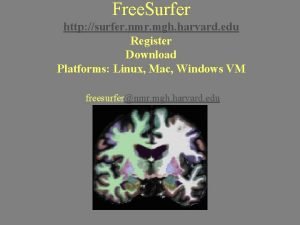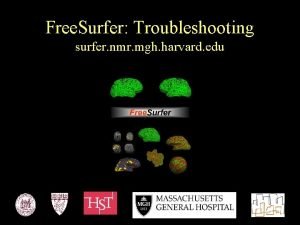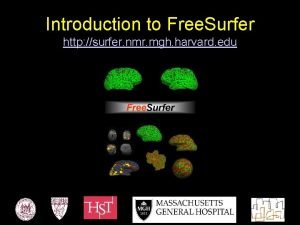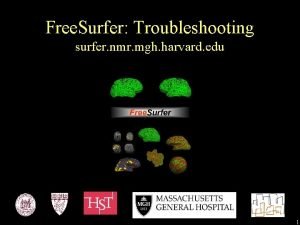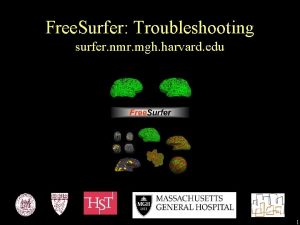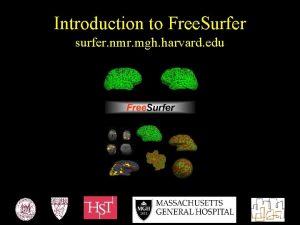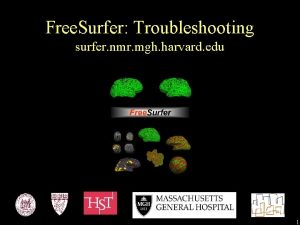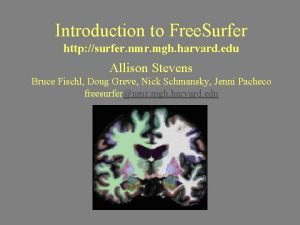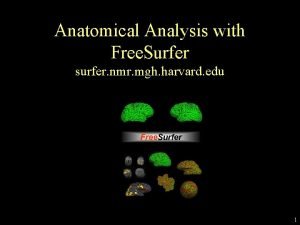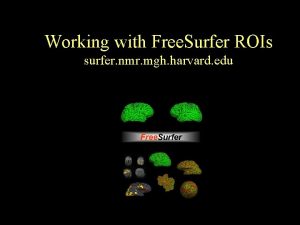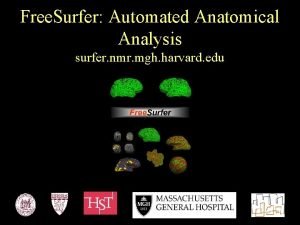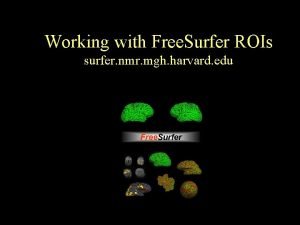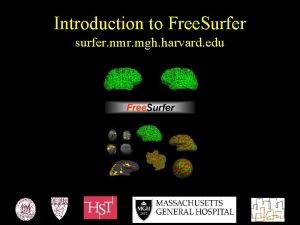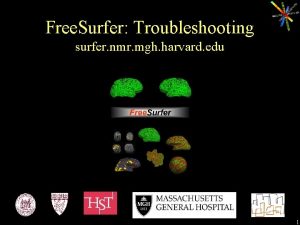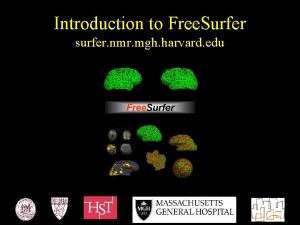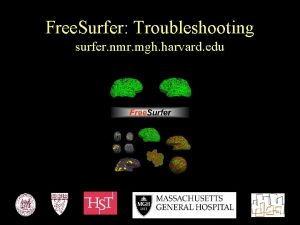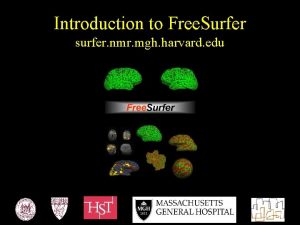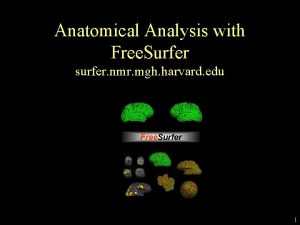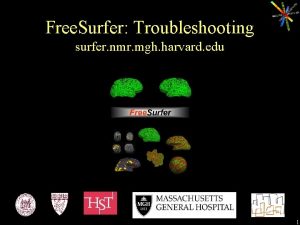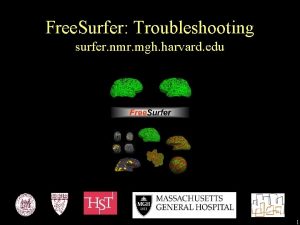EventRelated f MRI Experimental Design surfer nmr mgh










![Estimating Shape (FIR) • FIR = Finite [Time] Impulse Response • Within General Linear Estimating Shape (FIR) • FIR = Finite [Time] Impulse Response • Within General Linear](https://slidetodoc.com/presentation_image_h2/7356b4e0f9d94c124e8e5633f945f24f/image-11.jpg)





















- Slides: 32

Event-Related f. MRI Experimental Design surfer. nmr. mgh. harvard. edu

Overview • Stimulus schedule • which stimulus is presented when and for how long • Blocked design • Event-related designs • Motivation • Types • Analysis • Efficiency • Optseq • Stand-alone • Part of Free. Surfer http: //surfer. nmr. mgh. harvard. edu/optseq 2

Blocked Design 20 -60 sec fixation Stimulus Schedule Hemodynamic Response • Sequence of the same event type • Usually presented periodically • Measure Set, Strategy, State or as a Localizer • Individual stimulus not important 3

Blocked Design – Attention Task Match-to-Letter 2 A -Back + 2 -Back Match-to-Position A 2 -Back + B 1 -Back + A Current C + Current • Probe Attention to Letter vs Spatial Position • Don’t really care about individual stimuli 4

Blocked Design – Localizer Faces Buildings • Find areas in the brain that respond to Faces vs Buildings • Use as ROI for some other analyses • Efficiency (no adaptation) • Use overlap to build a larger signal (better SNR) 5

Overlap to build larger signal Two Stimuli, no overlap Two Stimuli, overlap Many Stimuli, overlap Blocked design Does not improve after 15 sec 6

Motivation: Psychology f. MRI Noise Spectrum Block Period=60 s Noise Floor Longer Shorter f. MRI Noise gets much worse at low frequencies! 7

Event-related Design • Care about response to individual event type • Random order of events • Often random timing of events Motivation • Avoid Set, Strategy, State, Adaptation • More natural than blocked • Want information about the shape (dynamics) • Avoid low frequencies Dealing with overlap in responses • Fixed Interval (no overlap) • Randomized (overlap) • Efficiency 8

Motivation: Psychology • Words vs Non-words • Press key 1 for words • Press key 2 for non-words • Cannot have a block of words, then a block of non-words chair silsaleu 9

Motivation: Shape Estimation Time-to-Peak (~6 sec) Dispersion TR (~2 sec) Equilibrium (~16 -32 sec) Undershoot Delay (~1 -2 sec) 10
![Estimating Shape FIR FIR Finite Time Impulse Response Within General Linear Estimating Shape (FIR) • FIR = Finite [Time] Impulse Response • Within General Linear](https://slidetodoc.com/presentation_image_h2/7356b4e0f9d94c124e8e5633f945f24f/image-11.jpg)
Estimating Shape (FIR) • FIR = Finite [Time] Impulse Response • Within General Linear Model (GLM) • Less efficient than blocked (usually) • Non-linear (estimate delay and dispersion) • Schedule is extremely important 11

Alternative: Assume an HRF Shape SPM FSL FSFAST • Assume a shape in analysis (most common) • Fit amplitude • Usually more powerful than not assuming a shape • Used in most analyses of blocked design

Fixed-Interval Event-Related 12 -30 s • Push trials apart enough to prevent overlap. • Interval fixed at minimum is most efficient. • Random Sequence (Counter-balanced) • Expectation? • Inflexible/Inefficient/Boring • Can shorten interval if assuming an HRF 13

Rapid-Presentation Event-Related + + + • Closely Spaced Task Trials (Overlap!) • Raw signal uninterpretable • More Stimulus Presentations for given scanning interval • Random Sequence • Jitter = “Random” Inter-Stimulus Interval (ISI/SOA) • Linearity Assumption • Do not need to assume a shape (but can) Dale and Buckner, 1997, HBM, 5: 329 14

Deconvolving with Jitter (FIR) Acquisition 1 True underlying responses Hypothesis 1 Consistent with Acq 1 Hypothesis 2 Consistent with Acq 1 Acquisition 2 Inconsistent with H 1 and H 2. Consistent with truth. 15

Example hemodynamic response They don’t all look this good! 16

Scheduling Random Designs • Choose: • Stimulus order • Stimulus onset time • Enormous flexibility • How to choose? • Efficiency • Linear model • Minimize parameter variance • Refractory Period 17

Linear Model Thickness Intercept: b Slope: m y 1 System of Linear Equations y 1 = b + x 1*m y 2 = b + x 2*m y 2 Age x 1 x 2 Independent Variable (x) -- you get to choose -- how? Intercept = Offset 18

Noise Estimated Intercept: b Estimated Slope: m Noise causes uncertainty and errors in estimation x 1 x 2 19

Effect of Noise { • Noise – variance (sn) • Variation in intercept (sb) • Variation in slope (sm) • Noise – (i. i. d) same for all X x 1 x 2 xb is efficiency for b 20

A Different Design • Move x 1, x 2 further apart • Noise stays the same (i. i. d) • Variation in intercept and slope drops. • Efficiency increases { Can compute efficiency from x before doing experiment. Choose x to maximize efficiency. x 1 x 2 For an event-related design, x = stimulus onset times (design matrix X) 21

Link to GLM Scanning Time ~ 1/Efficiency Dale, 1999, HBM 8: 109 -114. Optseq http: //surfer. nmr. mgh. harvard. edu/optseq 22

Example Design • 3 Event Types • 2 sec presentation time • 15 repetitions • 30 sec per event, 90 sec total • Minimum 2 sec fixation (+) between stimuli • f. MRI Acquisition • TR = 2 sec • Ntp = 120 (Run=240 sec) • Total Fixation Time = 240 -90 = 150 sec • FIR Analysis 23

Optseq Results Mean eff=0. 86 Variable fixation Scanning Time ~ 1/Efficiency 24

First Order Counter-balancing Preceded by Ideal Best Worst Ev 1 Ev 2 Ev 3 Ev 1. 333 Ev 1. 333. 467. 200 Ev 2. 333 Ev 2. 467. 067. 467 Ev 3. 333 Ev 3. 267. 333 Ev 3. 200. 400. 333 • Counter-balancing matrix • Probability that a condition follows itself or another condition • Predictability 25

How closely spaced can stimuli be? NI, 2000, 11: 547 • • • Too closely spaced causes loss of signal Refractory period Keep spacing > 2 sec 26

Summary • Random sequence of events • Often random timing of events • Psychology – avoid set, adaptation • Measure shape of HRF • Fixed interval (no overlap) • Jittered (overlap), linearity, deconvolve • Choose schedule based on efficiency • optseq • Part of Free. Surfer • Docs and tutorial at http: //surfer. nmr. mgh. harvard. edu/optseq 27

28

Optseq (optseq 2) • Software to aid in the design of event-related experiments • Chooses stimulus onset times given: • TR, Ntp • Duration and # of Repetitions of each Event Type Total Duration of f. MRI Run Cond 1 Cond 2 Cond 3 D 1*N 1 D 2*N 2 D 3*N 3 Total Fixation Time ~Mean Task Event 1. Randomly orders events 2. Chops fixation time into random bits 3. Inserts fixation between events (may be 0) 4. Builds FIR design matrix (X) 5. Computes efficiency, compares to max, keeps if greater 6. Return to step 1, repeat Nsearch times 29

Sample optseq 2 command optseq 2 --ntp 60 --tr 2 --psdwin -4 20 --ev English. Word 2 12 --ev English. Non. Word 2 12 --ev Spanish. Non. Word 2 12 --nsearch 10000 --o bilingual • 60 time points, TR=2, run time = 60*2=120 sec • FIR Post-stimulus Delay Window (psdwin) -4 to +20 sec • 4 event types, each 2 sec long, each presented 12 times (24 sec) • 4*2*12 = 96 sec of Task; 120 -96= 24 sec Fixation • Search over 10000 iterations • Save output in a file called “bilingual” 30

optseq 2 output Onset Time Code Duration Weight 0. 0000 2. 0000 4. 0000 6. 0000 8. 0000 10. 0000 12. 0000 14. 0000 18. 0000 20. 0000 … 3 0 2 0 1 0 4 0 2. 000 2. 000 4. 000 2. 000 1. 0000 1. 0000 Name Spanish. Word NULL English. Non. Word NULL English. Word NULL Spanish. Non. Word NULL English. Non. Word NULL Code: depends on order in the command line Weight: usually 1. 0. 31

Event Response Model (FIR) PSDMin PSD=0 PSDMax d. PSD • PSD: Post-Stimulus Delay (PSD = 0 = Stimulus Onset) • PSDMin: Response is zero for PSD < PSDMin • PSDMax: Response is zero for PSD > PSDMax • PSD Window should be long enough to capture response • Response can be anything in between (FIR model) • d. PSD: sets basic temporal resolution for schedule • DOF Constraint: Nbeta = n. PSD*Nc < Ntp 32
 Experimental vs non experimental
Experimental vs non experimental Experimental vs non experimental
Experimental vs non experimental Solomon four group design
Solomon four group design Experimental vs non experimental research
Experimental vs non experimental research Experimental vs non experimental
Experimental vs non experimental Dock foreman meaning
Dock foreman meaning Program surfer
Program surfer Newton dynamics
Newton dynamics Freesurfer group analysis
Freesurfer group analysis Surfer
Surfer Surfer
Surfer Surfer
Surfer Free
Free Tksurfer
Tksurfer Surfer
Surfer Surfer
Surfer Random surfer model
Random surfer model Surfer myelopathy
Surfer myelopathy Interpersonal skills in soul surfer
Interpersonal skills in soul surfer Fermisurfer
Fermisurfer Fermi surfer
Fermi surfer Magánhangzótörvények
Magánhangzótörvények Eg=mgh
Eg=mgh Parallel plate equipotential lines
Parallel plate equipotential lines Gpe=mgh example
Gpe=mgh example Mgh.harvard.edu
Mgh.harvard.edu Si units of work
Si units of work Epg=mgh
Epg=mgh Mgh haven
Mgh haven Eric rosenberg mgh
Eric rosenberg mgh Bacterial vaginosis under microscope
Bacterial vaginosis under microscope P= mgh/t
P= mgh/t Ep= mgh
Ep= mgh





